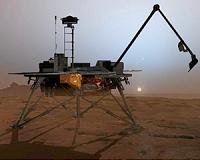 |
Tucson AZ (SPX) Oct 12, 2010 A new discovery of hydrothermally altered carbonate-bearing rocks on Mars points toward habitable environments deep in the Martian crust, a Planetary Science Institute researcher said. A deposit of carbonate rocks that once existed 6 km (about 4 miles) below the surface of Mars was uplifted and exposed by an ancient meteor impact, said Joseph Michalski, research scientist with PSI. The carbonate minerals exist along with hydrated silicate minerals of a likely hydrothermal origin. Using data returned from NASA's Mars Reconnaissance Orbiter (MRO) spacecraft, researchers have spotted this unique mineralogy within the central peak of a crater to the southwest of a giant Martian volcanic province named Syrtis Major. With infrared spectra from the Compact Reconnaissance Imaging Spectrometer for Mars (CRISM), planetary geologists detected the hydrothermal minerals from their spectroscopic fingerprints. Visible images from the High Resolution Imaging Science Experiment (HiRISE) camera aboard MRO show that the carbonates and hydrated silicate minerals occur within deformed bedrock that was exhumed by an ancient meteor impact that poked through the volcanic upper crust of Mars. "Carbonate rocks have long been a Holy Grail of Mars exploration for several reasons," Michalski said. "One reason is because carbonates form with the ocean and within lakes on Earth, so the same could be true for ancient Mars - such deposits could indicate past seas that were once present on Mars. "Another reason is because we suspect that the ancient Martian atmosphere was probably denser and CO2-rich, but today the atmosphere is quite thin so we infer that the CO2 must have gone into carbonate rocks somewhere on Mars." Michalski and co-author Paul B. Niles of NASA Johnson Space Center recently published the results in a paper titled "Deep crustal carbonate rocks exposed by meteor impact on Mars" in Nature Geoscience. While this is not the first detection of carbonates on Mars, Michalski said, "This detection is significant because it shows other carbonates detected by previous workers, which were found in a fairly limited spatial extent, were not a localized phenomenon. Carbonates may have formed over a very large region of ancient Mars, but been covered up by volcanic flows later in the history of the planet. A very exciting history of water on Mars may be simply covered up by younger lava!" The discovery also has implications for the habitability of the Martian crust. "The presence of carbonates along with hydrothermal silicate minerals indicates that a hydrothermal system existed in the presence of CO2 deep in the Martian crust," Michalski says. "Such an environment is chemically similar to the type of hydrothermal systems that exist within the ocean floor of Earth, which are capable of sustaining vast communities of organisms that have never seen the light of day. "The cold, dry surface of Mars is a tough place to survive, even for microbes. If we can identify places where habitable environments once existed at depth, protected from the harsh surface environment, it is a big step forward for astrobiological exploration of the red planet."
Share This Article With Planet Earth
Related Links Planetary Science Institute Mars News and Information at MarsDaily.com Lunar Dreams and more
 Missing Piece Inspires New Look At Mars Puzzle
Missing Piece Inspires New Look At Mars PuzzlePasadena CA (JPL) Sep 06, 2010 Experiments prompted by a 2008 surprise from NASA's Phoenix Mars Lander suggest that soil examined by NASA's Viking Mars landers in 1976 may have contained carbon-based chemical building blocks of life. "This doesn't say anything about the question of whether or not life has existed on Mars, but it could make a big difference in how we look for evidence to answer that question," said Chris ... read more |
|
| The content herein, unless otherwise known to be public domain, are Copyright 1995-2010 - SpaceDaily. AFP and UPI Wire Stories are copyright Agence France-Presse and United Press International. ESA Portal Reports are copyright European Space Agency. All NASA sourced material is public domain. Additional copyrights may apply in whole or part to other bona fide parties. Advertising does not imply endorsement,agreement or approval of any opinions, statements or information provided by SpaceDaily on any Web page published or hosted by SpaceDaily. Privacy Statement |